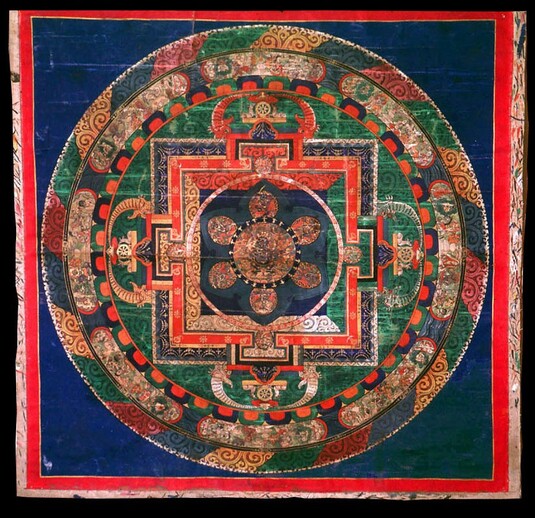
Item: Mandala of Mahakala (Buddhist Protector) - Panjarnata (Lord of the Pavilion)
| Origin Location | Tibet |
|---|---|
| Date Range | 1800 - 1899 |
| Lineages | Sakya, Ngor (Sakya) and Buddhist |
| Material | Ground Mineral Pigment, Fine Gold Line on Cotton |
| Collection | Southern Alleghenies Museum of Art |
Panjarnata Mahakala Twelve Deity Mandala. (Tibetan: gur gyi gon po nag po chen po lha chu nyi pa'i kyil khor, English: the Great Black One, Lord of the Pavilion [or Canopy] Twelve Deity Mandala). This composition belongs to a larger set of mandala paintings created for the ritual purpose of bestowing the initiation/empowerment into the practice of the Twelve Deity Panjara Mahakala - as a meditational deity. (See the Mahakala Main Page, Panjarnata Main Page and Outline Page).

In the central circle of the two dimensional mandala, on a blue six spoked weapon wheel is black Mahakala, with one face and two hands holding a curved knife and skullcup to the heart with an emanation stick placed across the forearms. Adorned with bone ornaments and wrathful vestments he stands on a corpse and lotus surrounded by the flames of pristine awareness.
Below Mahakala on the front spoke are the two deities Ekajati, with one face and two hands and Shri Devi with one face and four hands; riding a mule. Ekajati is situated slightly behind and above Shri Devi within the same circle of flame. On the remaining five spokes of the wheel are the Five Rakshasa attendants; Kala Rakshasa, Kali Rakshasa, Putra, Batra and Ekajati Rakshasi. They are all black in colour with one face and two hands holding a variety of implements and wearing various wrathful garments.
Surrounding the eight deities, outside the ring of skulls, are the four walls of the celestial palace with four 'T' shaped structures representing the four doors, each door is guarded by an animal headed goddess; lion, bear, wolf and pig. Above each door are four tiered steps, a Dharma wheel flanked by two deer and a silk canopy above. The entire palace structure sits atop a horizontal vishvavajra (crossed vajra scepter) with only the prongs visible, atop a giant lotus with the circle of alternating multi-coloured petals forming a ring (Sanskrit: padmavali).
Outside of that is the ring of the eight great charnel grounds with each cemetery clearly separated by a red border and blue water motif. Surrounding that is a ring of vajras (vajravali) and the outer ring composed of the five coloured flames (jvalavali) of pristine awareness fire atop a dark blue background.
This form of Panjarnata Mahakala belongs to the non-dual anuttarayoga tantra classification and performs the function of a meditational deity. This is one of several special Mahakala practices found in the Sakya Tradition of Tibetan Buddhism.
Lineage: Vajradhara, Dakini Vajrapanjara, Acharya Brahmin Vararuchi, Norbu Lingka Dewa'i Dorje, Shraddhakara Varman, Lochen Rinchen Zangpo, Drag Tengpa Yontan Tsultrim, Mal Lotsawa Lodro Dragpa, Sachen Kunga Nyingpo (1092-1158), etc.
Jeff Watt 7-1998
Mandala: Mandala Main Page
Buddhist Protectors: Enlightened
Collection of Southern Alleghenies Museum of Art
Buddhist Protector: Mahakala Main Page
Mandalas: Sakya Tradition
Mahakala: Panjarnata, Lord of the Pavilion (Main Page)
Mahakala: Panjarnata (Mandalas)
Collection of Southern Alleghenies: Protectors
Collection of Southern Alleghenies: Best of Collection
Collection of Southern Alleghenies: Mandalas
